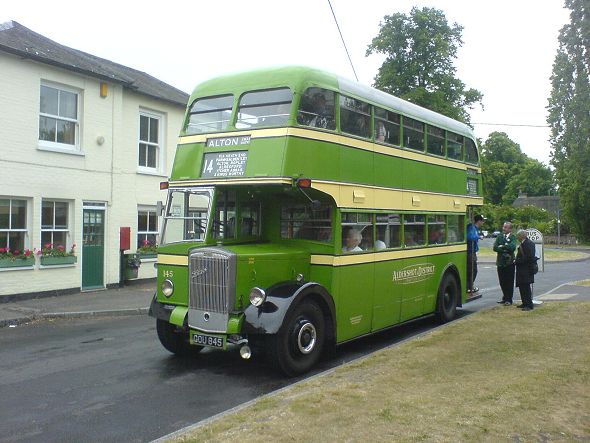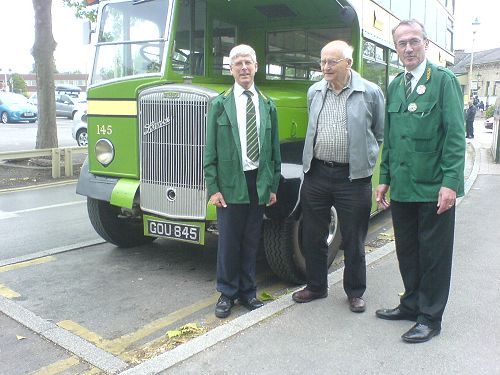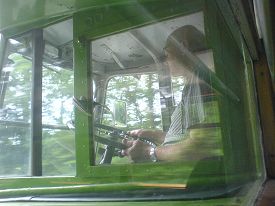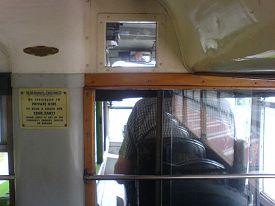|
Tim Stubbs wrote several articles relating to his preserved Dennis K3 bus - GOU845, fleet number 145. In the final one he recalls ex A&D drivers telling him, 'they were lovely vehicles to drive.' Many members may associate me with Norman Hamshere's two East Kent Dennis buses. Of those the Lancet J3 was, like the Lance K3, built in the early post war years, both chassis having the same combination of the Dennis '06' engine, twin plate clutch and '0' type crash gearbox with the pre-select overdrive. They both also had a Dennis worm and nut steering box and Dennis front axles, but differed in that the J3 had a Dennis rear axle, whilst the K3 had a Kirkstal axle. You could therefore be excused for assuming that, from the driver's point of view, they would be identical to handle. However when Tim invited me to join him and Malcolm on the WOMP/MHR free vintage bus service from Alton Station to Jane Austen's house at Chawton operated on Sunday 5th June, I very quickly found some significant differences. Both vehicles have a cab floor height of about 41ins and a step for the driver's left foot set into the body side panel at about 17ins above the ground for the K3 and much higher for the J3. However Norman Hamshere has modified his J3 by adding a step ring on the offside front wheel. Getting into the cab of the K3 proved to be quite an obstacle course at my age. Getting into the J3 is much easier using the step ring around the wheel nuts. Having got into the cab of the J3, the seat is well to the back of the cab - any further forward and you would not be able to engage reverse gear! Consequently the pedals and steering column are well forward and I suspect that any driver much shorter than my 6ft would need to sit on the front of the seat to reach the controls! The reason that the J3's seat needs to be so far to the back of the cab is that there is so much travel of the gear lever in both the fore and aft direction, as well as transversely. In 5th gear, the lever is close to the engine side cover and in reverse it is in front of the seat, so much so that I tend to move the lever fully to the right and between my legs before de-clutching and moving it towards the seat to engage reverse gear. Dennis must have revised the gear change linkage for the K3 to reduce the travel of the gear lever, with the result that all gears can be engaged without preventing the seat being moved forward. In fact, the seat in the K3 is so far forward that I found I was noticeably close to the steering wheel and the foot pedals, but I must admit that I am not as slim as Tim or Malcolm. The revised radiator and resultant lower bonnet line of the K3 allows you to see the nearside front wing, which is not possible from the cab of the J3. Initially, the difference in driving position, compared with that which I am familiar with in the East Kent J3, caused me some embarrassment. Firstly, when pulling away, I found that I was revving the engine more than I intended. Secondly, as I engaged the clutch, my left knee reached the steering the wheel before the clutch was fully engaged, leading to prolonged clutch slip as I pulled away or after changing gear. Fortunately, I soon had adapted myself to those characteristics. However I had not expected the embarrassment, which was to come later. In 1955 as an apprentice when I was in Dennis's Road Test shop, I drove several Max 6 lorry chassis with the same engine clutch and gearbox combination and cannot remember having any difficulty with the gearbox, and in 1997 when Norman Hamshere's East Kent J3 re-emerged, again I had little difficulty with it. However after driving the K3 from Medstead to Alton via Chawton, I made a left turn out of Chawton towards Alton in second gear and changed up to third, gained speed and began the change to fourth. Not being accustomed to the reduced movement of the gear lever, I am ashamed to admit, that I did not notice that whilst in neutral I had allowed the lever to move over to the first and second gear selector, with the result that I when I moved the lever back expecting to find fourth gear, I was in fact making an unintentional and very noisy attempt to engage second. At the end of the day, I had driven the K3 from Medstead Garage to Alton Station, one round trip on the Alton to Chawton free bus service and the return from Alton to Medstead, by which time I too had decided that, after acquainting myself with the vehicle, the K3 was a lovely bus to drive. The steering was positive and incredibly light and the '06' engine whilst typically not giving a sparkling performance pulled well at low revs, so much so that with Malcolm as passenger, the climb from Chawton to Four Marks was completed in fourth gear. On reflection, was any double decker built in the late 1940s significantly livelier, or handled any better than the K3, which I found extremely stable. I must thank Tim for a most enjoyable day, but would add a final comment. It may not be authentic for an A&D K3, but as you get older and less nimble, a step ring on the offside front wheel is a great aid to getting into the cab. Either that or consider someone adapting a stair lift!
|




